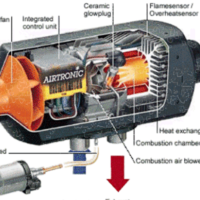I attached a picture of how they work, the bottom wording is missing, but the exhaust and fresh air for combustion are the holes on the bottom.
There is an internal combustion chamber surrounded by a heat exchanger. It looks like an air cooled motorcycle head but without a piston.
When you first turn the unit on, a glow plug starts to heat up and the fan motor begins to cycle. It pulls and pushes the shack’s breathing air over the heat exchanger, and another one is inside the combustion chamber to circulate combustion gasses (in and out from outside the shack).
Picture how you heat your truck. The engine has an intake under the hood, and an exhaust out the tail pipe. Inside your truck is a heater core (heat exchanger) with a fan. When you hit the recirculating button the same air in the cab is sent back over the heater core again to be reheated. Both systems are a closed loop, but you’re taking the heat from the engine (in this case the combustion chamber of the heater), without having exhaust gasses introduced or without using breathing air for combustion.
Next the “dosing” (fuel) pump activates and combustion starts to occur. It automatically adds more fuel and more air as the unit heats up. Once the heater itself is warmed up (takes a minute or two), the glow plug shuts off.
Now the unit is up and running. There is a perpetual blow torch going on inside without the glow plug. From here you dial the unit up or down for the desired amount of heat.
The hotter you want it, the faster the fan moves and the faster the dosing pump cycles. For less heat, the opposite happens.
Picture it like the heater in your truck or car, but with the fan control and temp control on the same knob.
They are meant to run continuous, which is also the most efficient way of heating. The heater uses around 10amps at start up with the glow plug on, then drops to .5 – 2.5 amps depending on your heat setting (which is directly correlated to fan speed).
By running continuous, you don’t get temp swings in the shack like with a standard RV furnace, which is running either 100% and pulling 6-10 amps (depending on size) or completely off. You just simply turn the digital control up or down to run at the desired setting.
When the shack starts out cold, I run both the diesel heater and my propane heater. I set the propane thermostat to 68 degrees.
The propane heater will run until it touches 68 and then begin cycle on and off, while the diesel heater keeps on running. Once the propane heater stops cycling, you know the shack and everything in it is up past 68 degrees.
From there I start to dial the diesel heater down, just like you would in your truck after you’ve been driving down the road for awhile and the cab is warmed up.
It might sound complicated but it’s very simple to do.
Once the shack is warm, if you turn the diesel heater down too low your propane heater will kick back on (and you know that you need to turn the diesel back up a little).
Attachments:

Screenshot_20220203-0901492.png




